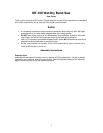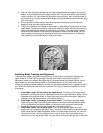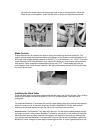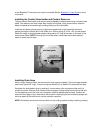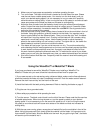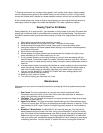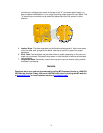8
7) Pushing too hard will not increase cutting speed. It will actually slow it down. Use the speed
control to adjust sawing speed to the material being cut and intricacy involved. For tight inside
curves and intricate work, operate at a slower speed to maintain control and not twist the blade.
8) If the blade seems limp, loose or slips on the wheels as you saw, adjust the blade tension or
tracking as outlined on page 3 and check the BladeSert™ for wear, replace as needed.
Sawing Tips For All Blades
Sawing effectively is an acquired skill. Just remember to let the blade do the work. Be aware that
sawing with a diamond blade is quite different than sawing with toothed blades. The diamond in
the blade is actually wearing away the material being cut rather than ripping fibers like a wood
blade.
1. Wear safety eye protection while operating your saw.
2. Never leave the saw running when not in use. The blade will last longer.
3. Guide the material straight into the blade. Never push or force the cutting action.
4. Use lighter pressure and slower speeds when starting a cut and then increase speed to
the desired cutting level.
5. Never twist or bend the blade.
6. Slower speeds and lighter pressure are recommended for intricate cuts, tight curves,
when completing a cut or when backing out of a cut.
7. If a dry powder appears on the cutting surface or in the air when wet sawing with the
diamond blade, more coolant (water) is needed. Check the reservoir level first. If there is
plenty of coolant, increase the drip rate by slowly turning the coolant adjustment screw on
reservoir.
8. If excess coolant (water) is spraying off the blade or coolant puddles on the work surface
when wet sawing, check the drip rate. You may also want to install the leather wiper to
help control excess water on the blade. (See page 4 for leather wiper instructions)
9. You can use the WoodCut™ or MetalCut™ blade "wet" when sawing plastics and
fiberglass to reduce heat and melting.
10. Keep out of the reach of children.
11. Turn off and unplug your saw when not in use.
Maintenance
Maintenance to your saw is minimal but important to prolonging the life and performance of the
machine.
1. Saw Frame: The main components of your saw are virtually maintenance free.
Periodically clean the interior of your saw. Either rinse clean with water or wood and
metal cutting residues can be vacuumed out.
2. The Motor: The unit is sealed and requires no internal maintenance. Make sure to keep
the entire unit clean and dry.
3. Upper Drive Wheel: The upper drive wheel needle bearing should be oiled about every
10 hours of running time. Do this by first emptying the coolant reservoir if need be. Tilt the
saw backward at a 45° angle. Place 4 to 6 drops of general purpose oil into the bearing
area.
4. BladeSert™ Blade Guide: The BladeSert™ will wear with saw use. The slot that the
blade passes through will widen over time. Using a worn BladeSert™ allows for excess
play in the blade and the blade becomes more likely to break. How fast this happens will
depend on use and your sawing style. You should check the BladeSert™ for wear each
time you use the saw. Immediately replace the BladeSert™ when it begins to show signs
of widening and wear. You can use the "X" behind the slot as a wear guide. When the



